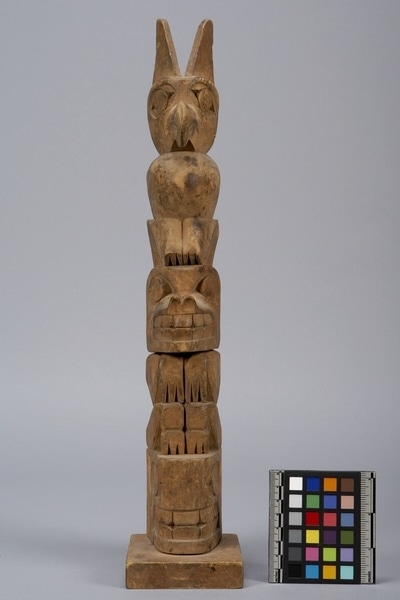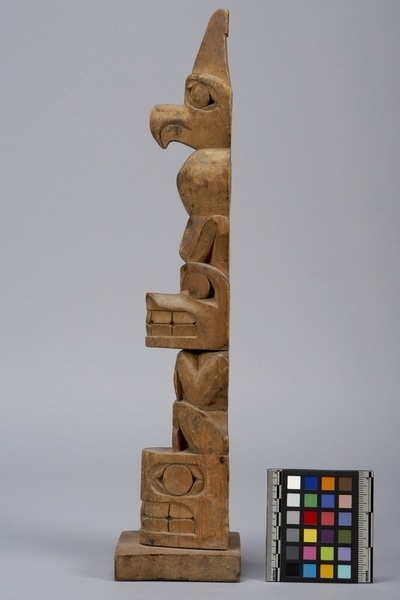Model Totem Pole Item Number: A8069 from the MOA: University of British Columbia




Description
Model totem pole depicting three animal figures: the pole has a square base on which sits the head of a fish surmounted by a bear figure and finally a thunderbird figure at the top. The pole is nailed to its base.
History Of Use
Traditionally, Coast Salish sculptures took the form of large-scale houseposts and boards, which were decorated with realistic looking animal, human and supernatural figures. Totem poles, originally only carved by their northern neighbours, became more popular in the early 20th century as tourist art. Many scholars feel that traditional styles of Coast Salish "art" were overlooked because it expressed private, non-secular experiences of the makers and they were reticent to discuss it or sell it to individuals outside of their communities. Miniature carved objects, such as totem poles and canoes, were popular forms of tourist art in the 20th century and are found in many museum collections.
Cultural Context
contemporary art; tourist art
Iconographic Meaning
The thunderbird plays a prominent role in an oral history from the Duncn area. At the Quw'utsun' Cultural and Conference Centre, interpreters tell the following story about the Thunderbird. "A long time ago a large whale blocked the mouth of the Cowichan river, consuming all the fish and causing the people of the area to go hungry. The young men went out to hunt the whale and were all lost. The old people prayed for help and the thunderbird heard their prayers and came down from his mountain. He lifted the whale into the air and carried it away, saving the people from starvation."
Item History
- Made in British Columbia, Canada
- Collected in Duncan, British Columbia, Canada between 1950 and 1962
- Owned by Chief Charlie Solwheymault
- Owned by Edith Bevan Cross before July 30, 1962
- Received from Edith Bevan Cross (Seller) and H. R. MacMillan (Funding source) on July 30, 1962
What
- Name
- Model Totem Pole
- Identification Number
- A8069
- Type of Item
- totem pole
- Material
- wood and metal
- Manufacturing Technique
- carved and nailed
- Overall
- height 42.5 cm, width 8.6 cm, depth 9.5 cm
Who
- Culture
- Coast Salish: Quwutsun'
- Previous Owner
- Chief Charlie Solwheymault and Edith Bevan Cross
- Received from
- Edith Bevan Cross (Seller) and H. R. MacMillan (Funding source)
Where
- Holding Institution
- MOA: University of British Columbia
- Made in
- British Columbia, Canada
- Collected in
- Duncan, British Columbia, Canada
When
- Collection Date
- between 1950 and 1962
- Ownership Date
- before July 30, 1962
- Acquisition Date
- on July 30, 1962
Other
- Condition
- fair
- Current Location
- Case 6
- Accession Number
- 0081/0089 a